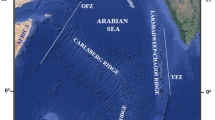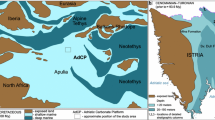Abstract
Shallow-marine microporous limestones account for many carbonate reservoirs. Their formation, however, remains poorly understood. Due to the lack of recent appropriate marine analogues, this study uses a lacustrine counterpart to examine the diagenetic processes controlling the development of intercrystalline microporosity. Late Miocene lacustrine microporous micrites of the Madrid Basin (Spain) have a similar matrix microfabric as Cenomanian to Early Turonian shallow-marine carbonates of the Mishrif reservoir Formation (Middle East). The primary mineralogy of the precursor mud partly explains this resemblance: low-Mg calcites were the main carbonate precipitates in the Cretaceous seawater and in Late Miocene freshwater lakes of the Madrid Basin. Based on hardness and petrophysical properties, two main facies were identified in the lacustrine limestones: a tight facies and a microporous facies. The tight facies evidences strong compaction, whereas the microporous facies does not. The petrotexture, the sedimentological content, and the mineralogical and chemical compositions are identical in both facies. The only difference lies in the presence of calcite overgrowths: they are pervasive in microporous limestones, but almost absent in tight carbonates. Early diagenetic transformations of the sediment inside a fluctuating meteoric phreatic lens are the best explanation for calcite overgrowths precipitation. Inside the lens, the dissolution of the smallest crystals in favor of overgrowths on the largest ones rigidifies the sediment and prevents compaction, while partly preserving the primary microporous network. Two factors appear essential in the genesis of microporous micrites: a precursor mud mostly composed of low-Mg calcite crystals and an early diagenesis rigidifying the microcrystalline framework prior to burial.








Similar content being viewed by others
References
Alsharhan AS, Nairn AEM (2003) Sedimentary basins and petroleum geology of the Middle East. Elsevier, Amsterdam, p 843
Arribas ME, Bustillo A, Tsige M (2004) Lacustrine chalky carbonates: origin, physical properties and diagenesis (Palaeogene of the Madrid Basin, Spain). Sediment Geol 166(3–4):335–351
Baronnet A (1982) Ostwald ripening in solution–the case of calcite and mica. Estud Geol 38:185–198
Bellanca A, Calvo JP, Censi P, Elizaga E, Neri R (1989) Evolution of lacustrine diatomite carbonate cycles of Miocene age, southeastern Spain; petrology and isotope geochemistry. J Sediment Res 59(1):45–52
Bellanca A, Calvo JP, Censi P, Neri R, Pozo M (1992) Recognition of lake-level changes in Miocene lacustrine units, Madrid Basin, Spain. Evidence from facies analysis, isotope geochemistry and clay mineralogy. Sediment Geol 76(3-4):135–153
Budd DA (1989) Micro-rhombic calcite and microporosity in limestones: a geochemical study of the Lower Cretaceous Thamama Group, U.A.E. Sediment Geol 63(3–4):293–311
Calvo JP, Daams R, Morales J, Lopez-Martinez N, Agusti J, Anadon P, Armenteros I, Cabrera L, Civis J, Corrochano A, Diaz-Molina M, Elizaga E, Hoyos M, Martin-Suarez E, Martinez J, Moissinet E, Muñoz A, Perez-Garcia A, Perez-González A, Porttero JM, Robles F, Santisteban C, Torres T, Van Der Meulen AJ, Vera JA, Mein P (1993) Up-to-date Spanish continental Neogene synthesis and paleoclimatic interpretation. Rev Soc Geol Esp 6(3–4):29–40
Calvo JP, Ordonez S, Garcia del Cura MA, Hoyos M, Alonso Zarza AM (1994) Madrid Basin (Neogene), Spain. In: Gierlowski-Kordesch E, Kelts K (eds) Global geological record of lake basins. University Press, Cambridge, pp 303–305
Calvo JP, Jones BF, Bustillo M, Fort R, Alonso Zarza AM, Kendall C (1995) Sedimentology and geochemistry of carbonates from lacustrine sequences in the Madrid Basin, central Spain. Chem Geol 123(1–4):173–191
Calvo JP, Alonso Zarza AM, Garcia del Cura MA, Ordonez S, Rodriguez-Aranda JP, Sanz Montero ME (1996) Sedimentary evolution of lake systems through the Miocene of the Madrid Basin: paleoclimatic and paleohydrological constraints. In: Friend PF, Dabrio CJ (eds) Tertiary basins of Spain: the stratigraphic record of crustal kinematics. University Press, Cambridge, pp 272–277
De Vicente G, Calvo JP, Munoz-Martin A (1996a) Neogene tectono-sedimentary review of the Madrid Basin. In: Friend PF, Dabrio CJ (eds) Tertiary basins of Spain: the stratigraphic record of crustal kinematics. University Press, Cambridge, pp 268–271
De Vicente G, Gonzalez-Casado JM, Munoz-Martin A, Giner J, Rodriguez-Pascua MA (1996b) Structure and tertiary evolution of the Madrid Basin. In: Friend PF, Dabrio CJ (eds) Tertiary basins of Spain: the stratigraphic record of crustal kinematics. University Press, Cambridge, pp 263–267
Dean WE, Fouch TD (1983) Lacustrine environment. In: Scholle PA, Bebout DG, Moore CH (eds) Carbonate depositional environments. AAPG, Tulsa, pp 98–130
Dickson JAD (2002) Fossil echinoderms as monitor of the Mg/Ca ratio of the Phanerozoic oceans. Science 298:1222–1224
Dickson JAD (2004) Echinoderm skeletal preservation: calcite-aragonite Seas and the Mg/Ca ratio of Phanerozoic oceans. J Sediment Res 74(3):355–365
Ehrenberg SN (2004) Factors controlling porosity in Upper Carboniferous-Lower Permian carbonate strata of the Barents Sea. AAPG Bull 88(12):1653–1676
Ehrenberg SN, Boassen T (1993) Factors controlling permeability variation in sandstones of the Garn Formation in Trestakk Field, Norwegian continental shelf. J Sediment Res 63(5):929–944
Eugster HP, Kelts K (1983) Lacustrine chemical sediments. In: Goudie AS, Pye K (eds) Chemical sediments and geomorphology: precipitates and residua in the near-surface environment. Academic Press, London, pp 321–368
Hardie LA (1996) Secular variation in seawater chemistry: an explanation for the coupled secular variation in the mineralogies of marine limestones and potash evaporites over the past 600 m.y. Geology 24(3):279–283
Instituto geologico y minero de Espana (1975) Mapa geologico de Espana 1:50’000: Chinchon. Inst Tecnol Geomin Esp, Madrid
Junco F, Calvo JP (1983) Cuenca de Madrid. In: Geologia de Espana vol 2. Inst Tecnol Geomin Esp, Madrid, pp 534–543
Kelts K, Hsü KJ (1978) Freshwater carbonate sedimentation. In: Lerman A (ed) Lakes: chemistry, geology, physics. Springer, Berlin Heidelberg New York, pp 295–323
Lambert L, Durlet C, Loreau J-P, Marnier G (2006) Burial dissolution of micrite in Middle East carbonate reservoirs (Jurassic–Cretaceous): keys for recognition and timing. Mar Petrol Geol 23(1):79–92
Lasemi Z, Sandberg PA (1984) Transformation of aragonite-dominated lime muds to microcrystalline limestones. Geology 12(7):420–423
Lasemi Z, Sandberg PA (1993) Microfabric and compositional clues to dominant mud mineralogy of micrite precursors. In: Rezak R, Lavoie DL (eds) Carbonate microfabrics. Springer, Berlin Heidelberg New York, pp 173–185
Leng MJ, Lamb AL, Heaton THE, Marshall JD, Wolfe BB, Jones MD, Holmes JA, Arrowsmith C (2006) Isotopes in lake sediments. In: Leng MJ (ed) Isotopes in palaeoenvironmental research. Springer, Berlin Heidelberg New York, pp 147–184
Lerman A (1978) Lakes: chemistry, geology, physics. Springer, Berlin Heidelberg New York, p 363
Loreau J-P (1972) Pétrographie de calcaires fins au microscope électronique à balayage: introduction à une classification des micrites. C R Acad Sci Paris 274(6):810–813
Lowenstein TK, Timofeeff MN, Brennan ST, Hardie LA, Demicco RV (2001) Oscillations in Phanerozoic seawater chemistry: evidence from fluid inclusions. Science 294:1086–1088
Morse JW, Casey WH (1988) Ostwald processes and mineral paragenesis in sediments. Am J Sci 288(6):537–560
Moshier SO (1989) Microporosity in micritic limestones: a review. Sediment Geol 63(3–4):191–213
Munnecke A, Samtleben C (1996) The formation of micritic limestones and the development of limestone-marl alternations in the Silurian of Gotland, Sweden. Facies 34(1):159–176
Ostwald W (1887) Lehrbuch der Allgemeinen Chemie. Verlag von Wilhelm Engelmann, Leipzig, p 909
Perkins RD (1989) Origin of micro-rhombic calcite matrix within cretaceous reservoir rock, West Stuart City Trend, Texas. Sediment Geol 63(3–4):313–321
Richard J, Sizun JP, Machhour L (2007) Development and compartmentalization of chalky carbonate reservoirs: the Urgonian Jura-Bas Dauphine platform model (Genissiat, southeastern France). Sediment Geol 198(3–4):195–207
Sandberg PA (1983) An oscillating trend in phanerozoic non-skeletal carbonate mineralogy. Nature 305:19–22
Sanz ME (1994) Sedimentologia de las formaciones neogenas del sur de la Cuenca de Madrid, con enfasis en los procesos karsticos asociados a las rupturas sedimentarias del Plioceno. Dissertation, Universidad Complutense de Madrid
Sanz E, Sesé C, Calvo JP (1992) Primer hallazgo de Micromamiferos de edad turoliense en la Cuenca de Madrid. Estud Geol 48:171–178
Siemann MG (2003) Extensive and rapid changes in seawater chemistry during the Phanerozoic: evidence from Br contents in basal halite. Terra Nova 15(4):243–248
Stanley SM, Hardie LA (1998) Secular oscillations in the carbonate mineralogy of reef-building and sediment-producing organisms driven by tectonically forced shifts in seawater chemistry. Palaeogeogr Palaeoclimatol Palaeoecol 144(1–2):3–19
Teranes JL, McKenzie JA, Lotter AF, Sturm M (1999) Stable isotope response to lake eutrophication: calibration of a high-resolution lacustrine sequence from Baldeggersee, Switzerland. Limnol Oceanogr 44(2):320–333
Utrilla R, Vázquez A, Anadón P (1998) Paleohydrology of the Upper Miocene Bicorb Lake (eastern Spain) as inferred from stable isotopic data from inorganic carbonates. Sediment Geol 121(3–4):191–206
Volery C, Davaud E, Foubert A, Caline B (2009) Shallow-marine microporous carbonate reservoir rocks in the Middle East: relationship with seawater Mg/Ca ratio and eustatic sea level. J Petrol Geol 32(4):313–325
Westphal H (2006) Limestone–marl alternations as environmental archives and the role of early diagenesis: a critical review. Int J Earth Sci 95(6):947–961
Wright VP, Alonzo Zarza AM, Sanz ME, Calvo JP (1997) Diagenesis of Late Miocene micritic lacustrine carbonates, Madrid Basin, Spain. Sediment Geol 114(1–4):81–95
Acknowledgments
This research was funded by the University of Geneva and by Total Exploration and Production. The review of a previous version of the manuscript by Axel Munnecke (University of Erlangen) is acknowledged with thanks.
Author information
Authors and Affiliations
Corresponding author
Rights and permissions
About this article
Cite this article
Volery, C., Davaud, E., Foubert, A. et al. Lacustrine microporous micrites of the Madrid Basin (Late Miocene, Spain) as analogues for shallow-marine carbonates of the Mishrif reservoir Formation (Cenomanian to Early Turonian, Middle East). Facies 56, 385–397 (2010). https://doi.org/10.1007/s10347-009-0210-8
Received:
Accepted:
Published:
Issue Date:
DOI: https://doi.org/10.1007/s10347-009-0210-8




